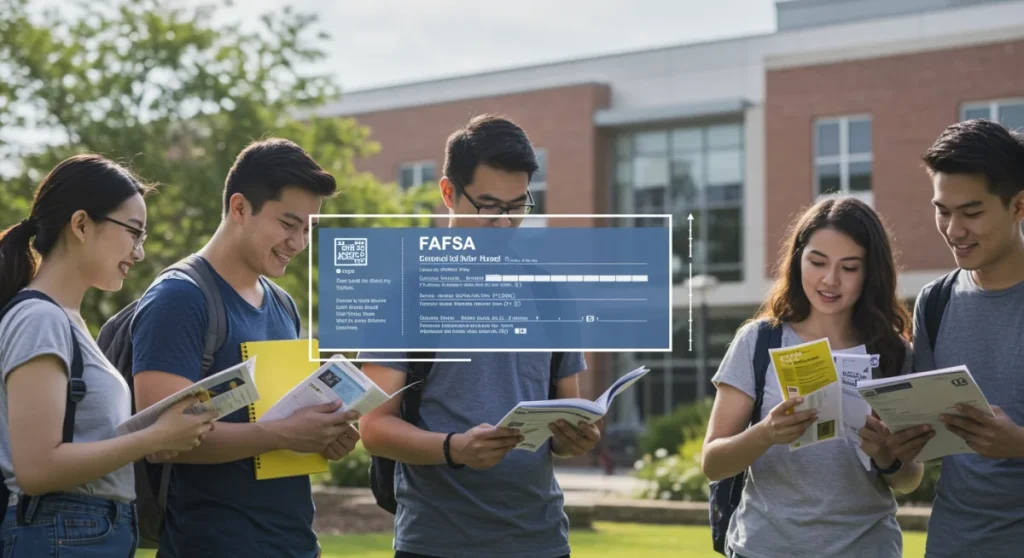2025 FAFSA Overhaul: 5 Key Changes for US College Aid

The 2025 FAFSA overhaul introduces a simplified application, changes to need calculation, and new eligibility rules that will significantly impact financial aid for US college students.
Preparing for college often involves navigating the complex world of financial aid, and for students eyeing higher education in the United States, understanding The 2025 FAFSA Overhaul: 5 Key Changes Affecting College Financial Aid for US Students is now more critical than ever. This significant revamp promises to streamline the application process and redefine how aid is distributed, directly impacting countless families.
The Simplified FAFSA Application Process
The foremost change coming with the 2025 FAFSA is a dramatic simplification of the application itself. Historically, the FAFSA was notorious for its length and complexity, often deterring students and families from completing it. The new iteration aims to reduce the number of questions significantly, making the process more accessible and less intimidating for applicants.
This streamlined approach is designed to remove barriers to financial aid, encouraging more students, particularly those from underserved communities, to apply. By cutting down on redundant questions and integrating data directly from the IRS, the Department of Education hopes to make financial aid a more straightforward reality for millions.
Reduced Question Count
The number of questions on the FAFSA form has been drastically reduced from over 100 to fewer than 50. This reduction is a direct response to feedback from students, parents, and financial aid administrators who consistently cited the form’s length as a major obstacle.
- Faster Completion: Students can now complete the FAFSA in a fraction of the time it previously took.
- Less Confusion: Fewer questions mean less ambiguity and a lower chance of errors.
- Increased Access: The simplified form is expected to increase the number of aid applications, especially from first-generation college students.
The goal is to transform the FAFSA from a daunting task into a quick, intuitive experience. This simplification is not just about convenience; it’s about equity, ensuring that financial aid is within reach for all eligible students, regardless of their background or prior experience with financial forms. The new system aims to be more user-friendly, reducing the stress associated with applying for federal student aid.
Ultimately, the simplified FAFSA application process is a welcome change that seeks to democratize access to higher education. By making the initial step of applying for aid less burdensome, more students will be empowered to pursue their academic dreams without being overwhelmed by administrative hurdles.
New Eligibility Criteria and the SAI
Perhaps one of the most impactful changes in the 2025 FAFSA overhaul is the introduction of the Student Aid Index (SAI), which replaces the Expected Family Contribution (EFC). The SAI is a new methodology for determining a student’s eligibility for federal student aid, and it brings with it several key shifts in how financial need is assessed.
The SAI aims to be a more equitable measure, focusing on a student’s ability to pay rather than simply a family’s income. This change is particularly significant for families with multiple children in college, as the previous EFC calculation often penalized these families by not adequately accounting for their combined educational expenses.
Student Aid Index (SAI) vs. Expected Family Contribution (EFC)
The shift from EFC to SAI is more than just a name change; it represents a fundamental rethinking of how financial need is determined. The SAI can be a negative number, as low as -1500, indicating a higher level of financial need and potentially qualifying students for more aid.
- Negative SAI Possible: A negative SAI signifies maximum financial need, potentially leading to increased Pell Grant eligibility.
- No Discount for Multiple Siblings: A major change is the removal of the EFC formula’s benefit for families with multiple children in college. Each student will now receive an individual SAI, which could mean less aid for families with several college-bound dependents.
- Expanded Pell Grant Eligibility: The new SAI methodology is expected to expand Pell Grant eligibility to more students, especially those with the greatest financial need.
These changes mean that families will need to re-evaluate their understanding of financial aid eligibility. What might have been true under the EFC system may no longer hold true with the SAI. It’s crucial for students and parents to familiarize themselves with the new calculation methods to accurately estimate their aid potential.
The new eligibility criteria, centered around the SAI, are designed to direct federal aid more effectively to those who need it most. While some families may see their aid packages change, the overall goal is to create a fairer and more transparent system for determining who qualifies for federal student assistance.
Changes to Income and Asset Reporting
The 2025 FAFSA also introduces notable adjustments to how income and assets are reported, impacting the calculation of the Student Aid Index (SAI). These changes are designed to simplify the reporting process and, in some cases, provide a more accurate picture of a family’s financial capacity to contribute to college costs. Understanding these shifts is vital for applicants to ensure they are providing correct information and maximizing their aid potential.
One of the most significant modifications is the direct data exchange with the IRS. This integration aims to reduce errors and fraud, while also simplifying the application for families by automatically importing tax information. However, it also means less flexibility in reporting certain financial details.
IRS Direct Data Exchange
The new FAFSA mandates the use of the IRS Direct Data Exchange (DDX) for all applicants and contributors (parents or spouses). This means that income data will be directly transferred from the IRS, eliminating the need for manual entry and reducing the possibility of mistakes.
- Mandatory Data Transfer: All federal tax information required for the FAFSA must be transferred directly from the IRS.
- Reduced Errors: Automation minimizes manual entry errors, leading to more accurate aid calculations.
- Privacy Concerns Addressed: While data is transferred, strict privacy protocols are in place to protect sensitive financial information.
Beyond the IRS integration, the FAFSA will now consider adjusted gross income (AGI) more prominently. Additionally, certain assets, such as small business equity and family farms, which were previously excluded, may now be counted in the SAI calculation, potentially impacting aid for some families. This change reflects an effort to capture a more comprehensive view of a family’s wealth.
These revisions to income and asset reporting require families to be aware of how their financial picture will be assessed under the new rules. It’s advisable to review all financial documentation carefully before starting the FAFSA application to ensure a smooth and accurate submission process.
Expanded Pell Grant Eligibility
A cornerstone of federal student aid, the Pell Grant, is set to become more accessible under the 2025 FAFSA overhaul. This expansion of eligibility is one of the most anticipated outcomes of the FAFSA Simplification Act, aiming to provide financial relief to a broader spectrum of low-income students and help them attain higher education without excessive debt.
The changes are primarily driven by the new Student Aid Index (SAI) methodology, which is designed to identify and support students with the greatest financial need more effectively. By allowing for a negative SAI, the system can better differentiate between students at the lowest income levels, making more of them eligible for the maximum Pell Grant award.

Automatic Maximum Pell Grants
A significant improvement is the provision for automatic maximum Pell Grants for certain income levels. Students whose household income falls below a specific poverty threshold, based on family size, will automatically qualify for the maximum Pell Grant award, simplifying the process and providing immediate assurance of substantial aid.
- Income-Based Automatic Awards: Students meeting specific income criteria will automatically receive the maximum Pell Grant.
- Increased Award Amounts: The overall value of Pell Grants is expected to increase for many eligible students.
- Streamlined Awarding: This automatic qualification reduces administrative burdens for both students and financial aid offices.
Furthermore, the overhaul also reintroduces Pell Grant eligibility for incarcerated students, addressing a long-standing barrier to educational opportunities for this population. This move is expected to have a transformative impact on rehabilitation and reintegration efforts.
The expanded Pell Grant eligibility is a critical component of the FAFSA redesign, reflecting a commitment to making college more affordable and accessible. It underscores the federal government’s goal to reduce financial barriers and ensure that more students can pursue and complete their degrees.
Definition of a ‘Contributor’ and Consent Requirements
The 2025 FAFSA introduces a new term, ‘contributor,’ which refers to anyone required to provide information and consent on the FAFSA form. This typically includes the student, the student’s parents (if dependent), and the student’s spouse (if applicable). Understanding who is considered a contributor and the new consent requirements is crucial for a smooth application process.
Each contributor must provide their consent for the Department of Education to access their federal tax information directly from the IRS. Without this consent, the FAFSA cannot be processed, and the student will not be eligible for federal financial aid. This emphasizes the importance of communication and cooperation among all parties involved in the application.
Mandatory Consent for All Contributors
For the first time, all contributors to a student’s FAFSA must provide explicit consent for the IRS to share their tax information with the Department of Education. This consent is non-negotiable and is a critical step in the application process.
- Required for Processing: FAFSA cannot be processed without consent from all identified contributors.
- IRS Data Exchange: Consent enables the direct transfer of tax data, simplifying income reporting.
- Impact on Divorced Parents: The new rules clarify which parent’s information is required, typically the one who provides the most financial support.
The introduction of the ‘contributor’ role and mandatory consent aims to standardize data collection and improve the accuracy of financial aid calculations. It also places a greater emphasis on the responsibility of all involved parties to participate actively in the application process.
Families should be aware that if a contributor refuses to provide consent, even if they would otherwise be eligible for aid, the student’s FAFSA will be incomplete and no federal aid will be awarded. This makes clear communication and proactive engagement essential for all applicants.
Impact on Specific Student Groups
The 2025 FAFSA overhaul is not a one-size-fits-all change; its effects will be felt differently across various student populations. While the overall goal is to simplify and expand access to aid, certain groups will experience more pronounced impacts, both positive and potentially challenging. Understanding these nuances is key for students to anticipate how the new system will affect their financial aid prospects.
For instance, students from low-income backgrounds are expected to benefit significantly from the expanded Pell Grant eligibility and the new Student Aid Index (SAI) methodology. However, families with multiple children in college may find their aid eligibility altered due to the removal of the sibling discount, necessitating careful planning.
Students from Low-Income Backgrounds
Students from low-income families are among the primary beneficiaries of the FAFSA changes. The expanded Pell Grant eligibility, particularly the automatic maximum awards for specific income thresholds, is designed to provide greater financial security for these students, making college more attainable.
- Increased Pell Grant Access: More low-income students will qualify for federal grants, reducing reliance on loans.
- Simplified Application: The easier application process removes a barrier often faced by first-generation college students.
- Focus on Need: The SAI better reflects true financial need, directing aid to those who require it most.
Conversely, students from middle- and high-income families, especially those with multiple siblings enrolled in college simultaneously, might see a reduction in their overall aid packages. The previous EFC calculation provided a discount for having multiple children in college, which is now eliminated under the SAI. This means each college-bound child will be assessed individually, potentially leading to higher out-of-pocket costs for these families.
Furthermore, students who are considered independent, such as those who are homeless or in foster care, will find a more streamlined process for confirming their independent status. This simplification aims to reduce the red tape that often delayed or prevented these vulnerable students from accessing aid.
In conclusion, while the 2025 FAFSA aims for broader equity, its specific impacts will vary. It is crucial for all student groups to understand how these changes apply to their individual circumstances and to seek guidance from financial aid professionals if needed.
| Key Change | Brief Description |
|---|---|
| Simplified Application | Fewer questions and direct IRS data exchange make the FAFSA faster and easier to complete. |
| Student Aid Index (SAI) | Replaces EFC, allowing for negative values and impacting how financial need is assessed. |
| Expanded Pell Grants | More students, especially low-income, will qualify for federal Pell Grants, some automatically. |
| Contributor Consent | All contributors must provide consent for IRS data sharing; without it, aid cannot be granted. |
Frequently Asked Questions About the 2025 FAFSA
The most significant change is the simplification of the application form, reducing the number of questions from over 100 to fewer than 50. This aims to make the process more user-friendly and accessible for all students and families.
The SAI replaces the EFC, serving as a new measure of a student’s eligibility for federal aid. Unlike the EFC, the SAI can be a negative number, indicating greater financial need. It also removes the benefit for families with multiple children in college.
Yes, the 2025 FAFSA is expected to expand Pell Grant eligibility, particularly for low-income students. Some students will automatically qualify for the maximum Pell Grant based on their household income relative to poverty levels.
A ‘contributor’ is anyone required to provide information and consent on the FAFSA, typically the student, parents, and/or spouse. Their mandatory consent allows the IRS to share tax data, and without it, the FAFSA cannot be processed for aid.
The new FAFSA eliminates the previous EFC formula’s benefit for families with multiple children in college. Each student will now receive an individual SAI, which may result in less aid for these families compared to the old system.
Conclusion
The 2025 FAFSA overhaul represents a monumental shift in how federal financial aid is administered, aiming to create a more equitable and accessible system for college students across the United States. From a simplified application process to the introduction of the Student Aid Index and expanded Pell Grant eligibility, these changes are designed to empower more students to pursue higher education. While some adjustments, like the impact on families with multiple college students, will require careful navigation, the overarching goal is to streamline aid delivery and reduce financial barriers, making college dreams a reality for a broader population. Staying informed about these key changes is the first step toward successfully securing financial assistance for future academic endeavors.






